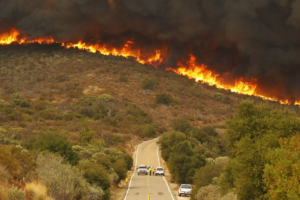1. Did I leave the oven on? Drones inside the home
Drones for aerial photos check. Drones for external surveillance and site visits check. Drones to go into dangerous locations check. But drones flying inside the home providing fully autonomous security surveillance? Recently unveiled, 2021 promises this technological evolution. There are obvious security benefits for homeowners and their insurers, such as checking whether windows have been left open or the oven left on. The drone can be triggered to fly and live stream to your phone either on demand or when a disturbance or intruder is detected. It can provide multiple views without multiple cameras. Here is the internet of things in action. But there are issues too. Privacy. Also, practically, the noise of the drone may alert any burglar, enabling them to knock the drone out of the air. The “Always Home Cam” may seem poorly timed when we are already always home. But when back at work, we might at least be able to check whether our puppies are happy!
2. Underwriters will focus on measure of indemnity wordings
In light of the Court of Appeal’s decision in Endurance v Sartex in March 2020, property underwriters should tighten up wordings to make it clear that, in the absence of actual reinstatement (or if for whatever reason the Reinstatement Condition does not apply), the measure of indemnity under the Insuring Agreement is diminution in market value.
Otherwise, the key question is `what measure of indemnity fully and fairly indemnifies the insured for its loss?’ The insured’s intention remains relevant when assessing the value of the property to the insured at the date of the peril. However, unless there is clear evidence that the insured had no intention to reinstate at the time of loss or that by reinstating the insured would not be mitigating its loss, the appropriate measure is reinstatement cost rather than diminution in market value.
3. Roll-up to reduce flooding
We are likely to see incentives, such as premium discounts, offered to homeowners to flood-proof their homes following Flood Re’s recommendations, which the Government will adopt. Measures are likely to include installation of floodgates, self-closing vents, flood resistant paint and relocation of electrical sockets. Eventually this is likely to be rolled out to all homeowners, not only those falling within high-risk flood areas. With urban surface water flooding striking even in low risk areas, all insurers are likely to look at how they can incentivise their policyholders and reduce future exposure.
4. Future cities this need not be the death of the office
The future of our cities hangs in the balance as we try and square competing demands of containing the spread of COVID-19 with allowing the economy to flourish. Working from home has meant an exodus from cities that then suffer from plummeting footfall and a drop in the need of the services that relied on the office traffic.
What is needed now is a rethink about our future city workspace. It needs to be flexible, responsive and energy conscious, facilitated by new technology PropTech – which can deliver greater efficiency and greater productivity. We also need better cycling and walking transport routes and green spaces. The appeal of the city is cyclical and we need innovation to draw businesses and people back with the offer of true face-to-face contact and camaraderie. We expect to see less of a production line and more of a laboratory for new ideas. Developers, landlords and businesses need to build on this opportunity and insurers need to support them.
5. Shift for mainstream home insurance to cover increased home working
2020 saw a rise in homeworking. Regular homeworking is likely to become the new norm. Staff embracing the flexibility of homeworking has advantages but it may affect home insurance cover. In March 2020 and latterly in October, the Association of British Insurers confirmed that “if you are an office-based worker and need to work from home because of government advice…, your home insurance cover will not be affected.” Nevertheless, when policies come up for renewal, home-working staff would be wise to make sure their insurers are aware and check the small print.
6. Feeling hot, hot, hot
After another glorious summer of high temperatures and dry conditions, the spotlight falls on perils such as subsidence. Subsidence caused by the close proximity of trees to properties is the only peril which is made worse by global warming but where the traditional response is to fell trees, thereby contributing to the exacerbation of global warming. The answer cannot continue to be to remove trees. What we will start to see is artificial intelligence being used more and more to improve the ability to risk profile areas and actively manage appropriate tree planting and effective tree maintenance. A harmonious balance between trees in the urban environment and housing stock must be reached.
7. As Easy as ADB
Ash die back (ADB) is a fungal tree disease which has been present in the UK since 2012. With more than 60 million ash trees outside of woodlands in the UK, it is estimated that the majority of them will become infected with ADB. There is no known cure and only 1% to 5% of the trees are immune to the disease. The disease itself causes particular branches of the tree to die-back by blocking the supply of water and nutrients to those branches. This can lead to branches failing and collapsing, posing a significant risk to human life, property, infrastructure and services. Land owners have had to move from a standing start in 2012 to take action to minimise the impact of ADB.
The Tree Council launched guidance for tree owners in June 2020 which impresses upon tree owners the importance of understanding the disease. The steps launched include identifying Ash trees and proactively inspecting and managing them to minimise their risk of failure. This is going to have a huge implication on land owners over the next five to 10 years as they work to avoid criminal and civil liability by effectively managing their ash tree stock. However, it is far more than simply working to avoid a legal liability. These Ash trees are part of the UK’s native deciduous rainforest and they are likely to be removed in the main from our landscape causing a huge environmental impact.
8. Mind the (social unrest) gap!
With continued civil discontent brewing across the globe, the (re)insurance market will need to reassess its strikes, riots and civil commotion (SRCC) product offerings and policy wordings to plug the growing protection gap but at what price for insureds? This trend is driven by complex factors, including anger at income inequality, food insecurity, political corruption and the overreach of the state, as well as increasingly polarised ideological battles.
As we predicted last year, social unrest has continued to grow globally and to have widespread insurance implications as it becomes ever more fractious. The coronavirus pandemic and resultant lockdowns may have put a lid on things, but the pressure is building as resentment blooms at the economic fallout of the pandemic. 2020 has been a catalyst for a hardening market and now coverage gaps are appearing for insureds.
Over the next twelve months, we expect to see a recalibration of the market as insurers perhaps start to add SRCC endorsements at a premium, fold such perils into political violence policies or offer entirely standalone cover. Meanwhile, insurers would do well to audit existing exposures and revise wordings to respond to the risks of social unrest more adaptively in different jurisdictions around the world.
9. A Chinese perspective: China’s property and casualty insurance market set to grow
Being `first in, first out’ with the COVID-19 pandemic, China reported a 4.9% growth of its economy year on year in the third quarter of 2020, with an annual expansion of 1.9% forecast by the International Monetary Fund. China’s property and casualty market is also expected to grow 8.8% annually from 2020 to 2030 in gross written premium.
As a result of COVID-19, major floods during the summer, and, interestingly, the accounting scandal of Luckin Coffee (when many of the public first learned about D&O insurance), the public’s risk awareness is likely to have further increased. Coupled with the government’s efforts to boost domestic demand via a new `dual circulation’ model, the strategy to shift investment to high tech industries, and reforms to permit 100% shareholding ownership by foreign insurers in China, this might lead to a greater presence of Western insurers in China in service lines where domestic players are less experienced, including liability (such as product liability, D&O and cyber), contingency and business interruption.
10. A French perspective: the French Treasury is working on a new insurance regime to be implemented in 2021
The French Treasury will announce the creation of a new insurance regime to cover business interruption losses, following the increase in disputes between insurers and insureds in relation to COVID-19. This plan would benefit small and mediumsized companies and would take the form of a capped lump sum, not covering all losses. Two regimes are being discussed.
The first is a public-private collective and compulsory insurance regime (similar to the existing `CatNat’ for acts of god losses), where the insured would pay a flat-rate premium that the State would top up and insurers would compensate for business interruption losses by paying a lump sum calculated individually. The second is an optional regime, encouraging companies to pay premiums for health risks in return for a tax advantage. The new regime should be introduced in spring 2021. However, at this stage there is no certainty as to the nature, form and scope of coverage.
11. A US perspective: California property insurers are likely to continue their exodus from fire-prone areas in the wake of the 2020 wildfires
In 2019, to slow the exodus of insurers, California implemented a moratorium on the cancellation and/or non-renewal of policies covering property in fire-prone areas. However, this expired in September 2020 and the expectation is that property insurers will resume their departure, potentially cratering the housing market if homes in such areas become uninsurable.
Any permanent solution to the problem will require a deal between California lawmakers, the property insurance industry and the federal government, which owns about 57% of California’s 33 million acres of forest land. In the current hyper-charged political atmosphere, no such solution is yet on the horizon.
12. An Australian perspective: climate class actions will force underwriters to consider risk of natural disasters
In addition to injury, property damage and business interruption claims, natural catastrophes can also give rise to class actions. In late 2019, the Supreme Court of New South Wales found in favour of the plaintiff/class in the Queensland Floods Class Action (brought against the dam operators for causing the floods) regarding the Wivenhoe and Somerset dam floods in South East Queensland in 2011.
An appeal is currently pending. Underwriters must continue to consider the risk of natural disasters for the customers and businesses they insure, particularly in high risk areas. As premium affordability continues to be an issue, the number of uninsurable risks will continue to rise. Insurance cannot be the only reconstruction solution. Experts are now calling for a levy on the fossil fuel industry for a climate disaster fund to help pay for the impact of natural disasters.
13. An African perspective: COVID-19 will accelerate growth of SME business property insurance in African markets
Although the African insurance market has grown over the last decade, the majority of African SMEs still view insurance as a nice add-on, as opposed to a `must have’. However, the COVID-19 pandemic has highlighted the importance of insurance cover. The pandemic ignited longstanding disaffection with a range of African governments’ policies, resulting in protests in some countries.
In Nigeria, for example, protests turned violent and resulted in damage to commercial premises, most of which were uninsured SMEs. With limited assistance from the government to get them back on their feet, it is fair to say that these businesses are now seeing insurance as less `nice to have’ and more `should have’.
14. A Latin American perspective: the silver lining on social unrest
In the past year we have seen different levels of social protests in countries such as Bolivia, Chile, Ecuador, Peru and Venezuela, leading to a large number of property losses and business interruption. All of these have had a significant impact on both the local markets and reinsurers.
It is very likely that such events will continue as these are emerging economies with `growing pains’ and there are a number of upcoming elections. However, this may be the very opportunity for the market to provide more comprehensive, sophisticated and, in all, better products to large and medium size companies. Such events force the industry to think outside the box in order to provide better insurance products covering risks such as riots and civil commotion or to consider different ways of covering multiple event losses. It will also be interesting to see how such events impact D&O policies, when large companies are forced to take decisions about their workforce.
Source: Lexology
Share this article:








